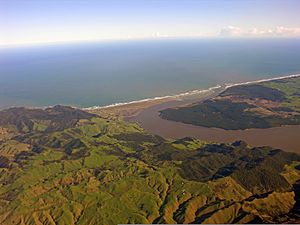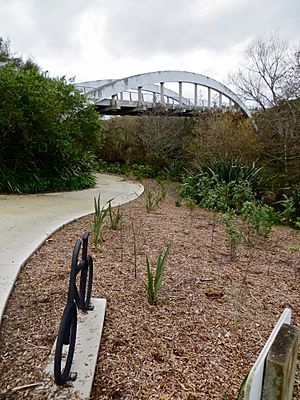Waikato River facts for kids
Quick facts for kids Waikato River |
|
|---|---|
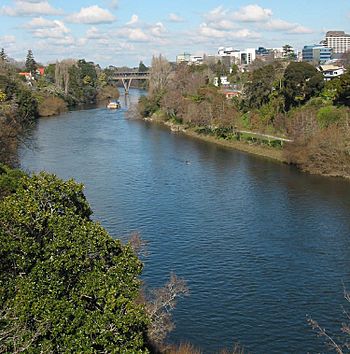
Waikato River passing through Hamilton
|
|
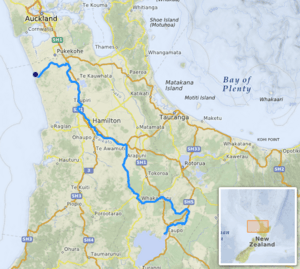
The Waikato River (interactive map)
|
|
| Country | New Zealand |
| Physical characteristics | |
| Main source | Lake Taupo |
| River mouth | Port Waikato 0.0 metres (0 ft) |
| Length | 425 kilometres (264 mi) |
| Basin features | |
| Basin size | 13,701 km2 (5,290 sq mi) to Mercer |
The Waikato River is the longest river in New Zealand. It flows for 425 kilometres (264 mi) across the North Island. The river starts high up on the eastern slopes of Mount Ruapehu. It joins the Tongariro River system and flows into Lake Taupo. Lake Taupo is New Zealand's largest lake.
After leaving Lake Taupo, the river forms the amazing Huka Falls. It then flows northwest through the flat Waikato Plains. Finally, it empties into the Tasman Sea at Port Waikato, south of Auckland. The river gives its name to the Waikato region. The main river path we see today was mostly formed about 17,000 years ago. The river's biggest branch is the Waipa River. They meet at Ngāruawāhia.
The name Waikato comes from the Māori language. It means flowing water. The Waikato River is very important to many local Māori tribes. This includes the large Tainui tribe. They see the river as a source of their mana, which means pride or spiritual power. The respected meeting place, marae of Tūrangawaewae, is right by the river in Ngāruawāhia.
For many years, the Tainui tribe has worked to reconnect with the river. This was after past conflicts and land being taken in the 1860s. They are still talking with the New Zealand government. In 2008, the government and Waikato-Tainui made an agreement about the river. Now, Waikato-Tainui helps manage the river with the Waikato Regional Council.
Contents
How the Waikato River Began
Long ago, the Waikato River flowed from an ancient lake called Lake Huka. This lake was in the middle of the North Island. The river flowed north through valleys and basins into the Thames Estuary. About 27,000 years ago, a huge volcanic eruption happened. This eruption covered the North Island with ash and rock. It created a new lake, which is now Lake Taupo.
Water built up in this new lake. Eventually, it broke through a new path. Over time, the riverbed filled with eruption debris. Then, the blocked path suddenly gave way. The lake level dropped quickly. A huge flood of water and debris poured out. This caused the river to change its path near Piarere. The river then flowed through the Maungatautari gorge and Hamilton Basin. Evidence shows the Waikato River was in this area 21,800 years ago.
The River's Journey
The Waikato River begins as many small streams. These streams are on the eastern side of Mount Ruapehu. One main source is the Mangatoetoenui Glacier. The southernmost stream is called the Upper Waikato Stream. The Waipakihi River joins from the Kaimanawa Mountains. From where it meets the Waihohonu Stream down to Lake Taupo, it is called the Tongariro River.
The Poutu Stream flows in from Lake Rotoaira. It joins the Tongariro, which flows north through Turangi. This part of the river is used to make hydroelectric power.
The Waikato River flows out of Lake Taupo at the town of Taupo. It then flows northeast past the town to the famous Huka Falls. About 40 kilometres (25 mi) from the lake, the river turns west. It flows into the southern end of Lake Ohakuri. It then leaves Lake Ohakuri and flows west through smaller lakes. These include Lake Atiamuri and Lake Whakamaru. It also passes through Lake Maraetai and Lake Waipapa. Here, the Waipapa River joins it. Then it flows north through Lake Arapuni and into Lake Karapiro.
Nine hydroelectric power stations use the river's energy between Taupo and Karapiro. All the lakes in this area, except Lake Taupo, are man-made.
The river leaves the Volcanic Plateau at Karapiro. It flows northwest into the Waikato Basin. It passes through towns like Cambridge, Hamilton, and Ngāruawāhia. Its largest branch, the Waipa River, joins it at Ngāruawāhia. The river then flows north through the Taupiri Gorge. Further north are Huntly and Meremere. Here, the Whangamarino and Maramarua Rivers join it.
From Mercer, the Waikato flows west and southwest. Just before it reaches the sea at Port Waikato, the Araroa River joins it. Many small islands are in the river's delta. The largest is Motutieke Island. There are also over 40 islands between Ngāruawāhia and Tuakau.
In the past, the Waikato's path sometimes shifted. It would flow north into the Firth of Thames. The last time this happened was about 20,000 years ago. The river's current path is mostly due to a huge volcanic eruption in 180 AD.
The river's average flow is 340 cubic metres per second (12,000 cu ft/s). The highest flows usually happen in July and August.
How People Use the Waikato River
The Waikato River has always been important for people living along its banks. It provides water and is a place for fun activities. In the past, it was a key way to travel and communicate. It used to take about three days to paddle a waka (Māori canoe) from Waiuku to the Cambridge area. Many towns are on or near the river, including Taupo, Hamilton, Huntly, and Port Waikato.
The Waikato River in Hamilton is often used for rowing, kayaking, and boating. Water-skiers and jet skis have special areas outside the city where they can be used.
The river was also important during conflicts in New Zealand in 1863–64. Battles were fought along its banks. Special gunboats were built to carry troops and supplies. New Zealand even had its first "navy" on the Waikato River, called the Waikato Flotilla.
Making Electricity
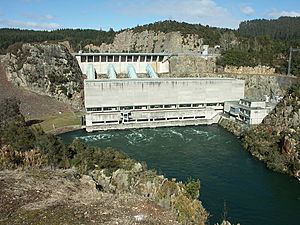
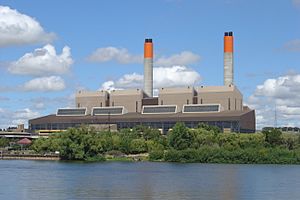
The Waikato River is a major source of hydro-electric power. The first power station, Horahora, was built to provide electricity for gold mines.
Today, the river has eight dams and nine hydro-electric power stations. These were built between 1929 and 1971. They generate electricity for the whole country. The power system starts at Lake Taupo. Gates control how much water flows into the river. It takes over 18 hours for the water to reach the last power station at Karapiro.
On its journey, the water passes through power stations at Aratiatia, Ohakuri, Atiamuri, Whakamaru, Maraetai, Waipapa, Arapuni, and Karapiro.
About 4,000 gigawatt hours of electricity are made each year. This is about 13% of all the electricity New Zealand produces.
The river also cools the Huntly Power Station. This power station burns coal and natural gas. It uses river water to cool its steam units. This means warm water is returned to the river. To protect the environment, there are rules about how much water can be taken. There are also rules about how warm the water can be when it goes back into the river (no more than 25 °C (77 °F)). In 2006, a cooling tower was added. This helps the power station run even on hot days.
Fun on the River

The lower Waikato River is popular for duck hunting.
Boating and Water Sports
The Waikato River is famous among whitewater kayaking fans. Especially the Full James rapid north of Taupo. This spot hosted the World Whitewater Championships in 1999.
Lake Karapiro is a man-made lake. It is known as one of New Zealand's best places for rowing. The World Rowing Championships were held here in 1978 and 2010.
The part of the river that flows through Hamilton is very busy. Many schools and clubs use rowing boats. Rowing races are also held here. Jet skis are kept to areas outside the city because of their noise. Power boats are often seen, especially in summer. There are also many kayaks and some waka.
There are many boat ramps along the river. These are managed by different local councils.
River Cruises
In the past, a ferry service ran along part of the river. One famous ferry was the Manuwai. It could carry 400 passengers. Today, public cruises operate from Aratiatia to Huka Falls. You can also take cruises from Hamilton Gardens to Mystery Creek. Since 2009, cruises also run from Tuakau to Port Waikato.
Walking and Cycling Trails
Three trails follow parts of the Waikato River.
The Waikato River Trails are a 100-kilometre (62 mi) series of trails. They are for both walkers and cyclists. They run between Lake Karapiro and Aratiatia. This trail opened in 2011.
The Te Awa River Ride follows over 50 km (31 mi) of the river. It goes from Horahora, near the end of the Waikato River Trails, through Cambridge and Hamilton to Ngāruawāhia. Part of this route includes a long cycle bridge near Horotiu.
Te Araroa is a long walkway that links the far north with the far south of New Zealand. It follows the Waikato River for most of its 80 kilometres (50 mi) between Mercer and Hamilton.
River Life and Environment
Animals and Plants
The Waikato River and its man-made lakes are home to many types of fish. There are at least 19 kinds of native fish. There are also 10 types of fish that were brought here by people. These include rainbow and brown trout. They offer "the finest fly-fishing in the world." But some introduced species, like carp and mosquitofish, have become pests.
Environmental Concerns
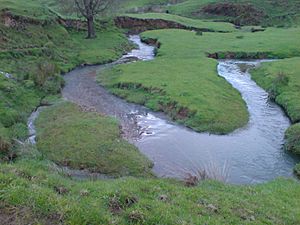
The land around the Waikato River is very good for farming. Because of this, a lot of agriculture happens there. This farming can cause agricultural pollution. Things like too much nitrogen fertilizer and animal waste can get into the groundwater and runoff. Since 2000, efforts have been made to use fertilizers more wisely.
Removing native plants for farmland has caused soil to wash into the river. This makes the river silty. Before the 1930s, floods would wash this silt out every winter.
Arsenic also enters the river. It comes from the Wairakei Geothermal Power Station. The amount of arsenic slowly decreases as the river flows north. This means the water is not safe for drinking unless it is treated.
Since 2002, a lot of water has been taken from the river at Tuakau. It is treated and then pumped to Auckland. This water helps meet Auckland's water needs. The treatment plant makes sure the water meets New Zealand's drinking water standards.
Some treated human waste is also put into the river downstream from towns. Hamilton city has a very modern water treatment system. It cleans the water to a high standard. New rules were put in place in 2002 to stop harmful substances from entering the water system.
Another issue is waste from old landfills and factories along the river. Some of these dumps are not properly lined. This means harmful chemicals can leak into the river.
See also
 In Spanish: Río Waikato para niños
In Spanish: Río Waikato para niños



